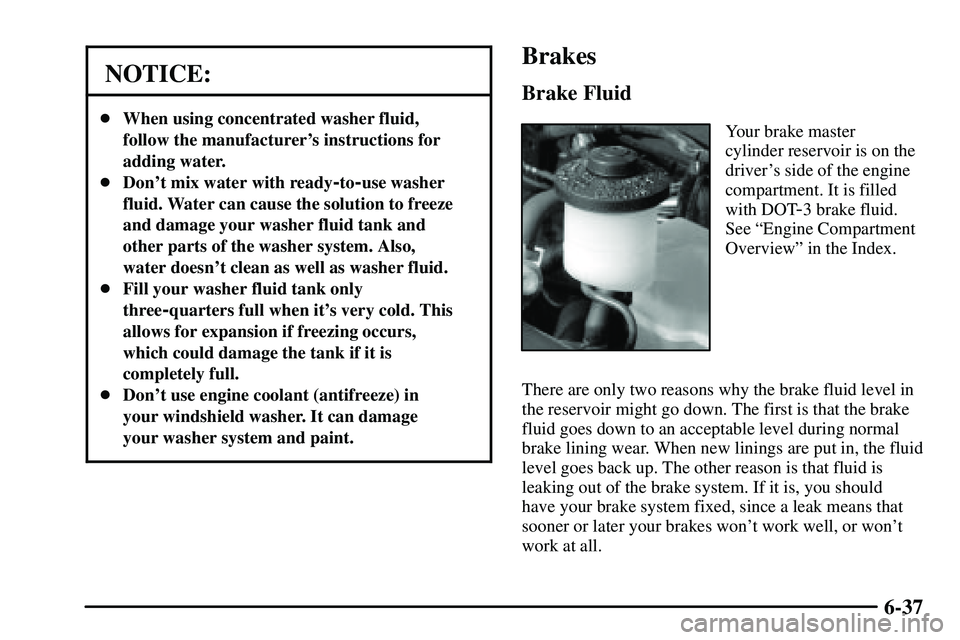Page 257 of 381
6-12 Engine Compartment Overview
When you open the hood of the 1.8 L (Code 8) engine, you'll see the following:
A. Windshield Washer
Fluid Reservoir
B. Power Steering Fluid Reservoir
C. Radiator Pressure Cap
D. Engine Oil DipstickE. Coolant Recovery Tank
F. Engine Oil Fill Cap
G. Automatic Transaxle Fluid
Dipstick (If Equipped)H. Brake/Hydraulic Clutch
Fluid Reservoir
I. Engine Air Cleaner/Filter
J. Battery
K. Engine Compartment Fuse Block
Page 258 of 381
6-13
When you open the hood of the 1.8 L (Code L) H.O. DOHC engine, you'll see the following:
A. Windshield Washer Fluid
Reservoir
B. Power Steering Fluid Reservoir
C. Radiator Pressure Cap
D. Engine Oil DipstickE. Coolant Recovery Tank
F. Engine Oil Fill Cap
G. Automatic Transaxle Fluid
Dipstick (If Equipped)H. Brake/Hydraulic Clutch Fluid
Reservoir
I. Engine Air Cleaner/Filter
J. Battery
K. Engine Compartment Fuse Block
Page 279 of 381
6-34
Radiator Pressure Cap
NOTICE:
Your radiator cap is a 15 psi (105 kPa)
pressure
-type cap and must be tightly installed to
prevent coolant loss and possible engine damage
from overheating. Be sure the arrows on the cap
line up with the overflow tube on the radiator
filler neck.
See ªEngine Compartment Overviewº in the Index for
more information on location.
Power Steering Fluid
When to Check Power Steering Fluid
It is not necessary to regularly check power steering
fluid unless you suspect there is a leak in the system or
you hear an unusual noise. A fluid loss in this system
could indicate a problem. Have the system inspected and
repaired. See ªEngine Compartment Overviewº in the
Index for reservoir location.
The power steering fluid
reservoir is located in the
engine compartment on
the passenger's side of
the vehicle.
Page 282 of 381

6-37
NOTICE:
�When using concentrated washer fluid,
follow the manufacturer's instructions for
adding water.
�Don't mix water with ready
-to-use washer
fluid. Water can cause the solution to freeze
and damage your washer fluid tank and
other parts of the washer system. Also,
water doesn't clean as well as washer fluid.
�Fill your washer fluid tank only
three
-quarters full when it's very cold. This
allows for expansion if freezing occurs,
which could damage the tank if it is
completely full.
�Don't use engine coolant (antifreeze) in
your windshield washer. It can damage
your washer system and paint.
Brakes
Brake Fluid
Your brake master
cylinder reservoir is on the
driver's side of the engine
compartment. It is filled
with DOT
-3 brake fluid.
See ªEngine Compartment
Overviewº in the Index.
There are only two reasons why the brake fluid level in
the reservoir might go down. The first is that the brake
fluid goes down to an acceptable level during normal
brake lining wear. When new linings are put in, the fluid
level goes back up. The other reason is that fluid is
leaking out of the brake system. If it is, you should
have your brake system fixed, since a leak means that
sooner or later your brakes won't work well, or won't
work at all.